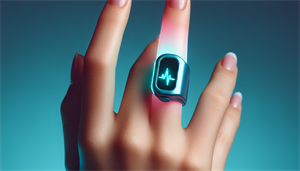Obstructive sleep apnea (OSA) is not unique to adults. Alarmingly, it also affects a significant number of adolescents, impacting their physical and emotional well-being. Despite being a serious condition, it often stays undiagnosed, as the signs are usually dismissed as typical teenage behavior.
However, once identified, “can teens have sleep apnea?” becomes a crucial question, and the answer is yes. Sleep apnea in teens can be effectively treated, significantly improving their quality of life.
Key Takeaways
-
Sleep apnea, including the most common type, obstructive sleep apnea, is a significant condition in adolescents, affecting their physical and emotional well-being with symptoms like snoring, breathing pauses, headaches, and daytime fatigue.
-
The impact of sleep apnea in teenagers extends beyond sleep quality to potentially severe physical health issues like hormonal imbalances, high blood pressure, and mental health problems such as depression and anxiety.
-
Diagnosis of sleep apnea in teens relies on a comprehensive evaluation including a sleep study, with treatment options ranging from lifestyle changes and CPAP therapy to surgical interventions, depending on severity.
Exploring Sleep Apnea in Adolescents
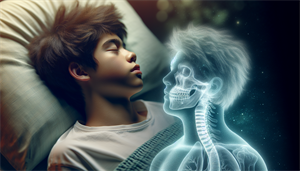
Sleep apnea is a sleep disorder characterized by disruptions in breathing during sleep, leading to reduced sleep quality and daytime exhaustion. It’s not a condition that only adults suffer from. Alarmingly, sleep apnea in adolescents is a significant condition that can have a profound impact on their physical and emotional well-being, with obstructive sleep apnea being the most prevalent type.
Spotting the signs of sleep apnea early is vital in preventing the harmful effects this condition can impose on a teen’s health and overall well-being. Some signs to look out for include:
-
Loud snoring
-
Pauses in breathing during sleep
-
Restless sleep
-
Morning headaches
-
Daytime sleepiness
-
Difficulty concentrating
-
Irritability
If you suspect that your teen may have sleep apnea, it’s important to consult with a healthcare professional for a proper diagnosis and treatment options.
Various treatments are available to treat sleep apnea in teenagers. However, the first step towards effective treatment is understanding what we are dealing with. Within this context, gaining insight into pediatric obstructive sleep apnea and its recognition is crucial.
Defining Pediatric Obstructive Sleep Apnea
Pediatric obstructive sleep apnea is characterized by the collapse of the upper airway during sleep, resulting in disrupted breathing and compromised sleep quality. This condition is the predominant form of sleep apnea observed in children and adolescents. The primary cause of this condition is the excessive relaxation of the muscles in the back of the throat during sleep, leading to the obstruction of the airway. This can result in mouth breathing and disrupted sleep, which are key signs of the disorder.
Diagnosing this condition necessitates distinguishing between types, given that both Obstructive and Central Sleep Apnea can affect children and teens. Obstructive sleep apnea is diagnosed in children and teenagers when they experience more than one interruption in their breathing per hour of sleep. This indicates that the condition is not just a minor inconvenience but a significant health concern that requires proper diagnosis and treatment.
Recognizing the Signs of Sleep Apnea in Teens
Identifying the signs of sleep apnea in teenagers is paramount to prompt diagnosis and treatment. The predominant indicators of obstructive sleep apnea in adolescents comprise snoring, gasping for air, and restless sleep. But these are not the only signs. Adolescents suffering from sleep apnea may also encounter daytime sleepiness, leading to behavioral challenges and affecting their overall alertness during the day.
However, there are less obvious signs of sleep apnea in teenagers that are often overlooked. These include:
-
Waking up with a dry mouth or scratchy throat
-
Frequent morning headaches
-
Difficulty concentrating or remembering things
-
Frequent waking up during the night
-
Mood swings
-
Irritability
-
Changes in sex drive or sexual dysfunction
Parents, caregivers, and educators need to be cognizant of these signs, as early detection can expedite treatment and avert long-term health complications.
The Impact of Sleep Apnea on Teen Health and Well-being
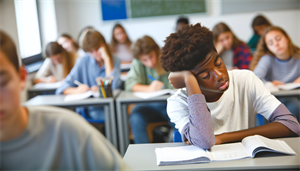
The influence of sleep apnea on a teenager’s life extends beyond their sleep quality and can have far-reaching effects. Physically, sleep apnea can lead to inadequate growth and elevated blood pressure. Obesity and older age are significant risk factors for developing sleep apnea in children, further emphasizing the need for maintaining a healthy lifestyle from an early age.
But the effects of sleep apnea are not just physical. Teenagers with sleep apnea may struggle to regulate their behaviors and emotions, which could impact their social interactions and cause difficulty falling asleep. Furthermore, there is a strong correlation between sleep apnea in teenagers and mental health problems, including depression and anxiety. Such emotional and cognitive issues can have a significant impact on a teen’s academic performance and overall quality of life.
Physical Health Complications
Obesity and older age are significant predictors of the severity of obstructive sleep apnea (OSA) in children, with up to 60% of obese children experiencing OSA. This underscores the importance of maintaining a healthy weight and lifestyle. Furthermore, sleep apnea, specifically obstructive sleep apnea, in teenagers can lead to heart problems such as high blood pressure, which is more likely to develop in teens with this condition. Nasal breathing can be affected by sleep apnea, causing disruptions in sleep.
Additionally, adolescents with sleep apnea may potentially experience hormonal imbalances including:
-
Decreased sex steroid and/or gonadotropin levels
-
Delayed puberty
-
Excessive growth hormone production
-
Growth hormone deficiency
Maintaining a healthy sleep schedule can help manage sleep apnea symptoms and mitigate these associated health risks.
Emotional and Cognitive Effects
Sleep apnea in adolescents can result in psychological consequences such as depression and anxiety, and can also impair their ability to regulate behaviors, emotions, and social interactions. Furthermore, the correlation between sleep apnea in adolescents and mood disorders is significant. It has been found that sleep apnea in adolescents is associated with an increased risk of developing mood disorders such as depression and bipolar disorder.
Emotional distress induced by sleep apnea can manifest in teenagers as:
-
Depression
-
Anxiety
-
Aggression
-
Various social and emotional difficulties
Additionally, teenagers with sleep apnea may encounter difficulties with memory and concentration. These emotional and cognitive effects can significantly impact a teenager’s quality of life, making it crucial to diagnose and treat sleep apnea as early as possible.
Diagnosing Sleep Apnea in the Teenage Years
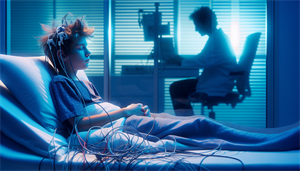
The process for diagnosing sleep apnea in teens involves a comprehensive evaluation, including an overnight sleep study and consultation with a sleep medicine specialist. A sleep study, also known as polysomnography, serves as a diagnostic tool to identify and diagnose sleep apnea and other sleep disorders. It plays a crucial role in the evaluation process for adolescents who are suspected of having sleep apnea.
During a sleep study, specialists observe various vital signs, breathing patterns, brain activity, heart rate, oxygen levels, and limb movements to evaluate the existence and severity of sleep apnea in a child’s sleep. The results of the sleep study are then interpreted by a pediatric sleep medicine specialist to make a diagnosis of sleep apnea or identify other underlying sleep disorders.
The Role of Sleep Studies
Sleep studies, which monitor breathing patterns, oxygen levels, and other vital signs during sleep, are fundamental in diagnosing sleep apnea in teenagers. The methods utilized for diagnosing sleep apnea in adolescents through sleep studies include drug induced sleep endoscopy (DISE), physical exam, and polysomnography (PSG).
Polysomnography (PSG) is performed by monitoring and recording various body systems of a teenager during sleep in an overnight study. This involves the application of sensors to record brain waves, breathing patterns, snoring, and oxygen levels. A sleep study carefully monitors factors such as adenotonsillar hypertrophy, obesity, and other clinical manifestations in teenagers. It measures brain activity, heart rate, breathing patterns, and the amount of sleep to accurately diagnose sleep apnea.
When to See a Sleep Medicine Specialist
It is advisable for a teenager to seek consultation with a sleep medicine specialist for sleep apnea when they display symptoms such as poor academic performance, attention difficulties, learning or behavioral problems, and poor weight gain, all of which may suggest disrupted sleep due to sleep apnea. The sleep medicine specialist is responsible for reviewing the symptoms and medical history, conducting a physical exam, and collaborating with a multidisciplinary team to diagnose sleep apnea in adolescents.
The severity of teen’s sleep apnea is assessed by a sleep medicine specialist, who can also be referred to as a sleep specialist, through a thorough review of symptoms and medical history, a comprehensive physical examination, and particularly via polysomnography, which is considered the gold standard for evaluating sleep patterns and breathing disruptions. Depending on the severity of the condition, the sleep medicine specialist may recommend treatments such as topical nasal steroids, oral medications, positive airway pressure therapy, and, in certain situations, surgical removal of enlarged tonsils for adolescent sleep apnea.
Treatment Pathways for Teens with Sleep Apnea
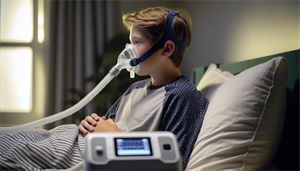
Once a teenager has been diagnosed with sleep apnea, the next step is to explore treatment options. Available medical treatments for adolescents with sleep apnea encompass the utilization of CPAP (Continuous Positive Airway Pressure) therapy or surgical interventions, contingent on the severity of the condition. However, medical interventions are not the only course of action. Lifestyle modifications, such as weight loss and practicing good sleep hygiene, can contribute to improved breathing during sleep and overall treatment effectiveness for teenagers with sleep apnea.
The choice of treatment hinges on factors such as the severity of sleep apnea, the physical characteristics of the upper airway, and the teenager’s personal preference and lifestyle. In some cases, a combination of treatments may be necessary. Bear in mind that treating sleep apnea is a long-term commitment necessitating consistent follow-up care and lifestyle alterations.
Lifestyle Modifications for Improved Sleep Health
Lifestyle modifications are often the first line of treatment for teenagers diagnosed with sleep apnea. Some important lifestyle modifications for addressing sleep apnea in overweight or obese teens include:
-
Weight loss through improved nutrition and increased exercise
-
Developing a plan under the guidance of a pediatrician
-
Setting realistic goals for gradual weight loss
These modifications can help improve sleep apnea symptoms and overall health.
In addition to weight loss, other lifestyle modifications such as maintaining good sleep hygiene and limiting screen time before bed can also contribute to improved sleep health and manage sleep apnea symptoms. Allergies, which can result in nasal congestion and blockage, causing teens to breathe through their mouth, can elevate the risk of snoring and obstructive sleep apnea. Thus, addressing any underlying allergies or nasal congestion is also an important part of managing sleep apnea in teenagers.
Medical Treatments and Continuous Positive Airway Pressure (CPAP) Therapy
For more severe cases of sleep apnea, medical treatments may be necessary. Typical surgical interventions for adolescents with obstructive sleep apnea comprise tonsillectomy and adenoidectomy, with an 80 percent success rate, and maxillomandibular advancement for older adolescents to widen the airway by advancing the upper and lower jaws.
Another common treatment option is Continuous Positive Airway Pressure (CPAP) therapy, which involves the use of a mask and machine to maintain open airways during sleep for teenagers. However, maintaining adherence to CPAP therapy can be challenging, especially when teenagers are exposed to new environments such as college dormitories. Furthermore, the choice of CPAP mask is crucial to avoid restricting facial growth.
In some cases, non-invasive treatments such as myofunctional therapy and the use of oral appliances may be recommended.
Preventative Measures and Parental Guidance

Preventing sleep apnea is just as important as treating it. Parents can play a significant role in averting sleep apnea and promoting their teenager’s overall sleep health by fostering a supportive home environment and promoting healthy habits. Parental guidance and involvement play a pivotal role in the management and prevention of sleep apnea in teenagers.
Parents can mitigate their teenager’s risk of developing sleep apnea by fostering a home environment that promotes healthy sleep habits and lifestyle. This involves:
-
Advocating good sleep hygiene
-
Restricting screen time
-
Minimizing caffeine consumption
-
Establishing a regular sleep schedule
-
Fostering warm and supportive interactions.
Establishing a Supportive Home Environment
A conducive home environment for preventing sleep apnea in teenagers can be established by practicing good sleep hygiene, limiting screen time, reducing caffeine intake, maintaining a consistent sleep routine, and using supportive pillows to aid proper head and neck alignment. Parents can establish a consistent sleep schedule for teenagers by implementing strategies such as setting a firm bedtime, creating a calming bedtime environment, avoiding overscheduling, and limiting the use of electronics before bedtime.
Addressing psychological concerns is also a critical part of managing sleep apnea at home. Frequently observed psychological concerns in adolescents with sleep apnea encompass difficulty focusing, irritability, poor impulse control, and aggression. To alleviate these concerns at home, parents should cultivate a supportive and calming sleep environment, advocate for good sleep hygiene, and seek medical treatment for sleep apnea.
The family plays a vital role in managing sleep apnea in teenagers by providing crucial support for lifestyle changes, such as weight loss, which can alleviate symptoms.
Encouraging Healthy Habits
In addition to creating a supportive home environment, parents can also help their teenagers develop healthy lifestyle habits that can prevent sleep apnea and promote overall well-being. Regular exercise, such as mouth and throat exercises and myofunctional therapy, can aid in controlling sleep apnea in teenagers by strengthening the muscles around the airways. A balanced diet combined with supervised aerobic exercise can result in weight loss and enhanced aerobic capacity, leading to improved, higher-quality sleep for teenagers with sleep apnea.
Adolescents with sleep apnea can also benefit from incorporating fruits and vegetables high in antioxidants, such as vitamins C and E into their diet. Stress management is significant in preventing sleep apnea in teenagers as it improves sleep hygiene, promotes better sleep, and prevents disturbances in breathing. Teenagers are advised to utilize relaxation techniques including deep breathing exercises, mindfulness, controlled breathing, visualization, progressive muscle relaxation, and self-hypnosis as effective measures to manage their stress levels.
Summary
In conclusion, sleep apnea in teens is a serious issue that warrants attention. Recognizing the signs of sleep apnea, understanding the impacts it can have on a teenager’s physical and emotional health, seeking timely diagnosis, and implementing effective treatment strategies are crucial. Parents play a vital role in managing and preventing sleep apnea in their teens by creating a supportive home environment, encouraging healthy habits, and seeking medical help when necessary. Early detection and intervention can significantly improve the quality of life for teenagers with sleep apnea.
Frequently Asked Questions
What are 3 symptoms of sleep apnea?
The three symptoms of sleep apnea are loud snoring, episodes of stopped breathing during sleep, and gasping for air during sleep. If you are experiencing these symptoms, it's important to seek medical advice.
Can sleep apnea go away?
No, sleep apnea cannot go away entirely, but its symptoms can be treated with oral appliances, CPAP machines, or other therapies. It's a chronic condition that requires long-term management.
How do you test for sleep apnea?
To test for sleep apnea, you can undergo a polysomnogram or sleep study, which can be conducted in a lab or at home. Alternatively, you can also opt for a nocturnal polysomnography test to monitor various bodily activities during sleep.
How many years can you live with sleep apnea?
With treatment, people with severe sleep apnea under 50 can expect to live between eight to 18 years. It's crucial to seek diagnosis and appropriate therapy for this condition.
What is Pediatric Obstructive Sleep Apnea?
Pediatric Obstructive Sleep Apnea is the predominant form of sleep apnea in children and adolescents, characterized by the collapse of the upper airway during sleep. It results in disrupted breathing and compromised sleep quality.

